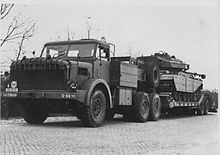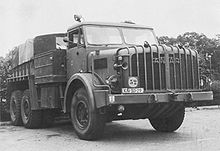- Thornycroft Antar
-
The Mighty Antar was a heavy-duty tractor unit built by Thornycroft from the 1940s onwards. For some decades it was the standard tank transporter of the British Army and was also used by other nations.
Contents
History
Origins
The civilian version of the Antar was developed in the late 1940s as an oilfield vehicle for transporting pipes over rough ground.[1] They were of 6x4 layout (i.e. six wheels, four of them driven), with the front (steering) axle undriven and with twin wheels on both driven (rear) axles. The vehicle was designed from the outset for off-road use, like the earlier Scammell Pioneer and unlike the road-going Diamond T it was eventually to replace.
The engine, the Meteorite, was a cut-down V8 version of the V12 Rolls-Royce Meteor used in tanks, itself a non-aero version of the Merlin and made under licence by the Rover Co Ltd. Early Antars used the petrol version made by Rover and by the early 1950s the Rolls-Royce-manufactured diesel versions of the engine.[2]
Choice of the "Mighty Antar" name
The name "Antar" was a reference to Antar Ibn Shadded, a pre-Islamic Arab poet-warrior. The intended lead customer for the "Mighty Antar" was the Anglo-Iranian Oil Company, previously the Anglo-Persian Oil Company, and this was a deliberate move to flatter the customer.[citation needed]
Introduction into Army service
In 1951, the first Antars entered British Army service. These were fixed-body steel-built ballast tractors and were given the design number FV 12001 and the designation Tractor 30-ton GS 6x4.[1] They could haul the new 50-ton Dyson FV 3601 trailers that were being used to carry the new and heavier Centurion tanks.[3] A 20-ton winch was fitted behind the cab, although just provided for loading the trailer rather than for recovery.
At this time, the intention was that the even heavier Conqueror tank would be transported by a whole new transporter of equally large capacity, the Leyland FV 1000.[4] This was 2 feet (61 cm) wider than the Antar, as the Antar had in turn been 2 feet (61 cm) wider than the Diamond T. They were to be equipped with a semi-trailer of 60 tons capacity, given the design number FV 3301. This design was ungainly and top-heavy when loaded, being high at the rear to clear the wheels and sloping downwards towards the front to better place the weight of the load.
Partly inspired by this semi-trailer, a new FV 12002 version of the Antar was developed as a tractor unit to haul it. This was a graceful swan-neck design and had only a small hump over the rear wheels, making loading by the rear ramps simpler. The trackways on which the tank sat were carried outboard of the trailer frame itself, which rose up between them at the front to form the swan neck, sloping only gently to clear the tank's hull. This gave a stronger and yet more compact layout than the ungainly step of the FV 1000 project's. The first version of this was the 16-wheeled FV 3001 of 60 tons capacity. This was later refined as the FV 3005 with smaller wheels, then the 50-ton-capacity FV 3011 (when using the Taskers/Sankey trailer) for carrying the Centurion.[1]
As the semi-trailer Antars entered service through 1953 to 1955, and after the abandonment of the FV 1000 project, they replaced the American Diamond T that had served during the Second World War as the British Army's main tank transporter.
Recovery vehicles
The Antar tractor itself was heavier, at 20 tons, than any available recovery vehicle could lift for a suspended tow. There had been plans in the super-heavy FV 1000 and FV 1200 series for recovery vehicles, but these were cancelled with the rest of the project. As an ad hoc measure in 1952, an RASC officer devised a bolt-on recovery jib that could be fitted to one Antar to make it capable of the suspended towing of another, although this modification was never approved for mass production.[5]
Later service
In the early 1960s the Mark 3 entered service, to support the increasing weight of later Centurion models and also future plans for the Chieftain tank. These were the last Antars in service, remaining until the mid-1980s.[6] The Mark 3 is visually distinct from the earlier models, the use of an inline engine rather than the wide vee of the Meteorite allowing a much narrower bonnet.
The Mark 3 used either a 50- or 60-ton semi-trailer (numbered as FV 12004) or could be converted to the FV 12006 ballast tractor configuration for hauling the 50-ton Dyson full trailer.
Replacement
By the late 1960s, it was clear that the Antar, even when re-engined, was an old design and replacement would be needed. There was also concern over the spares situation, as they were out of production and Thornycroft had been absorbed, via AEC, into the vast mass of Leyland. The Antar was replaced by the Scammell Commander in 1986.[7]
Specification
Antar Mark 1B
1B denotes ballast body for Dyson trailer.
- length: 26 ft (7.9 m)
- width: 10 ft 3 in (3.1 m)
- height: 10 ft (3.0 m)
- weight: 43,240 lb (19,610 kg)
- Engine: Rolls Royce 18.4 litre Meteorite Mk-204 V8 petrol (60 degree overhead cam, four valve, twin carb, twin magneto with two spark-plugs per cylinder). Power: 285 bhp (213 kW) at 2,000 rpm.
- Transmission: Four-speed full "crash gearbox" with three-speed transfer casing and power takeoff. Two live worm-drive rear axles with inboard epicyclic reduction.
- speed: 28 mph (45 km/h) on level ground.
Antar Mark 2A & B
2A denotes articulated for Dyson 50-ton semi-trailer or Sankey 60-ton semi-trailer.
Basically the same as the Mk 1 but for relocation of the two x 100 gallon fuel tanks stacked the rear of the cab, to saddle in the centre of the vehicle. A Dowty 20-ton winch is now located rear of the cab and a PTO-driven hydraulic pump to serve the Sankey semi-trailer loading ramps and wheel changing jacks.
One Mark 2 was converted with an AEC diesel engine for army trials in 1963, being sold off in 1971.[6]
Antar Mark 3
A&B
- Engine:Rolls-Royce C8SFL 16.2 litre 8-cylinder supercharged diesel engine
- power: 365 bhp (248 kW)
Totally new, narrower, body and cab.[8] The inline engine permitted a much narrower bonnet than the Meteorite's wide vee. The gearbox was similar but the main stick (gear lever) gave six speeds with a single stick for all winch and PTO control functions.
A third differential was fitted to the second axle, with a cab-operated diff-lock.
Max speed 35 mph (56 km/h).
With the Chieftain MBT the all-up weight was 101 tons; they were road-tested at 126 tons. [9]
References
- ^ a b c Baxter, Breakdown, p.71
- ^ "Tractor 30 ton 6 x 4 Tank Transporter Thornycroft Antar (Acc 1991.3573)". REME museum. http://www.rememuseum.org.uk/vehicles/ttt/vehantar.htm.
- ^ "Trailer 50 ton Tank Transporter (Acc 1991.3579)". REME museum. http://www.rememuseum.org.uk/vehicles/ttt/vehtr50.htm.
- ^ Baxter, Breakdown, p.70
- ^ Baxter, Breakdown, p.73
- ^ a b Baxter, Breakdown, p.85
- ^ Baxter, Breakdown, p.95
- ^ "Antar Mk3, showing narrower bonnet and rounded cab.". Tank Transporter Network. http://tanktransporter.ning.com/photo/antar2-1.
- ^ 15 years experience of overhauling Antars at the contract repair workshops "Fazakerly Engineering Company" Field Lane, Fazakerly, Liverpool.
Further reading
- Pat Ware (1997). Antar: FV12000 Series in British Army Service. Warehouse Publications. ISBN 0952556359.
- Pat Ware (1995). Tugs of War: Heavy Recovery Vehicles, Tank Transporters and Artillery Tractors of the British Army, 1945-1965. Warehouse Publications. ISBN 0952556316.
- Baxter, Brian S. (1989). Breakdown: A History of Recovery Vehicles in the British Army. HMSO, for REME Museum. ISBN 0-11-290456-4.
External links
UK military vehiclesLight-weight Load carriers Transporters "Mighty Antar" · Scammell CommanderRecovery & engineering UK Armoured Fighting VehiclesCategories:- Thornycroft military vehicles
- Tank transporters
- Military trucks
- Armoured fighting vehicles of the United Kingdom
- Soft-skinned vehicles
- Off-road vehicles
Wikimedia Foundation. 2010.




